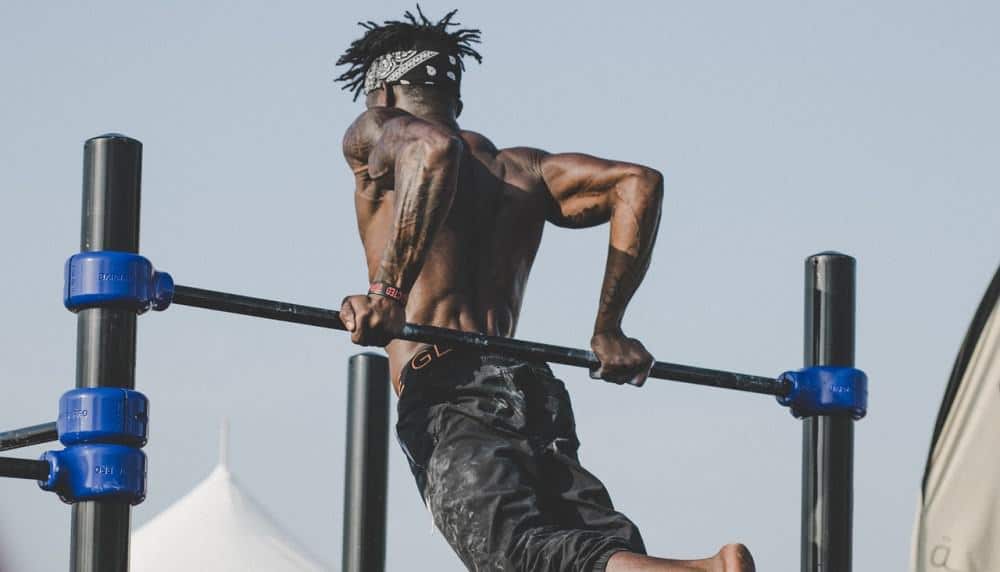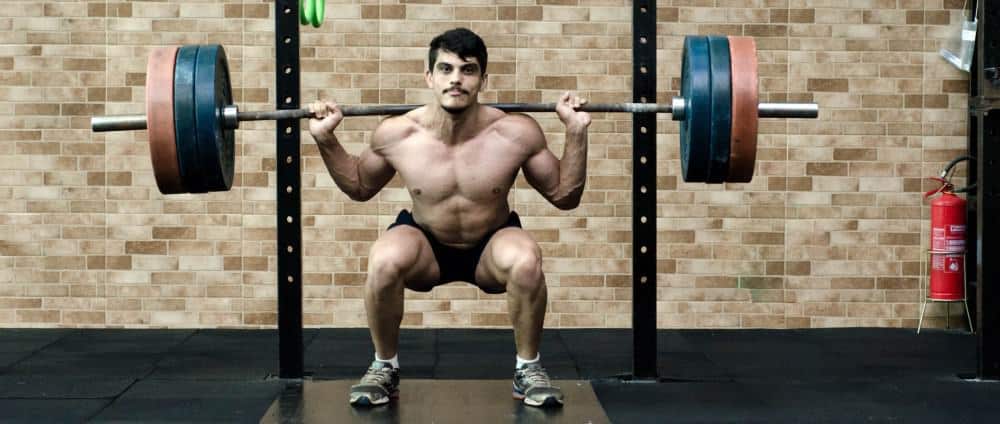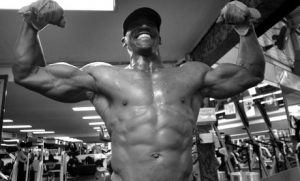FST-7 stands for “Fascia Stretch Training“. Its main focus is on building muscle.
The “7” stands for the number of sets that are completed at the end of each workout, for each specific muscle group.
In principle, the main idea revolves around having a good pump in our muscles.
And let’s be honest, guys, who do not like the feeling of a good, and proper pump?
For all among yourselves who do not have a clue about what I mean with “pump”, don’t worry, I’ll come back to that later on.
However, it’s not all about the pump, that’s just one tiny detail in the whole system designed to maximize hormonal response which in return, should result in maximum muscle growth.
Before we get more in-depth, let’s first clarify what the idea behind FST-7 is. In the end, I’ll share with you a premade sample training plan to illustrate and merge all pieces altogether.

FST-7 Training – The basic idea
The fascia tissue spans our muscles. These fasciae are individually different in strength and thickness.
The basic idea of the FST-7 training system relates to the following assumption; the stronger and tighter the fasciae are, the less growth space our muscles have.
In order to change this and to widen the fasciae, they need to be stretched regularly because only then will our muscles get enough space to grow properly.
However, the stretching should not be done by lengthening but rather by stretching from the inside out.
The most effective way to do this is by increasing the blood flow inside the muscles, in other words, to pump up the muscle so that it grows fast during a short period of time.
For example, pump sets are particularly suitable for that. This is also what the “7” stands for, 7 sets in number in the last exercise.
Nevertheless, FST-7 training does not solely concern fasciae stretching.
Heavyweight training between 8-12 reps is just as important and a major part of this system.
Notice that only the final exercise is performed on FST-7, specifically with a focus on a great pump and fascia stretching.
To sum up, the basic idea behind FST-7 is the following;
when skeletal muscles are exposed to significant tension, which in turn destroys muscle fibres, there is an increase in contractile proteins such as actin and myosin.
Eventually, this results in an expanded muscle cross-section through which force and muscle mass gains arise.
In addition, the body also faces a greater challenge in removing the metabolites, e.g. lactate exposed, which has increased the production of anabolic hormones.
As you can see, the FST-7 triggers a real chain reaction of events in the human body.
The quintessence of the whole is simply said:
a larger muscle leads to a higher power potential and this, in turn, means you can move more weight.
Once the target muscle is sufficiently stimulated or damaged, hypertrophy is the inevitable consequence. And that is exactly what you’re all looking for, isn’t it?
Building muscle is in principle nothing else than small microtraumas that are initiated in our muscles during training which prompts our body to repair, and build even stronger and bigger muscles.
In other words, more muscle fibres are built among the repaired muscle fibres to prevent reenacted microtraumas. As a result, muscles grow.
How does it work?
As described above, the FST-7 is more of an intensity technique used at the end of the workout for each muscle group.

Like all intensity techniques, the FST-7 should mainly be considered by advanced athletes that already mastered exercise technique and execution.
Not only does this avoid injuries but also increases the involved muscle fibres and respectively, muscle growth.
So, if you are just getting started, then this method may not be the exact best thing for your current condition.
For all others among yourselves that already have some experience and feel ready to give it a shot, feel free to try it out, but be cautious.
The FST-7 works best if you’re stuck in a training plateau phase and need some new incentives to overcome it.
This can boost your muscle growth anew.
As always, you should save intensity techniques such as these as a real wild card for the plateaus.
In practice, the FST-7 gets added upon your current workout volume in the last set.
Since this is about maximum muscle pump, it does not make sense to start with it at the beginning of your workout.
Keep in mind that the 7 sets should be performed with maximum mind muscle-connection to get the best possible feeling.
In contrast to the loaded stretching, the connective tissue gets stretched from the inside as a result of the pump.
The connective tissue, which otherwise reacts rather sluggishly to growth, is stretched perfectly by extreme blood flow, whereby it ends up with the desired effect.
With this in mind, the idea behind FST-7 is not growing by weight, but by stretching to maximize the pump.
The more consciously you train, the better your mind muscle-connection and eventually the more spectacular the outcomes will be.
In order to get the best pump, there are a couple of very simple and common tricks that you can follow.
I think I’ve mentioned these in literally most of the articles that I wrote about fitness.
Only use weights that you can control with a proper range of motion and technique.
Simple but effective.
Think of it this way. If you can’t handle a certain weight slowly and controlled, why would you risk injuries and simultaneously diminish the effectiveness or your workout?
Factors like the range of motion, execution, and technique can exert tremendous influence on the mind-muscle connection, correspondingly the pump and thereby the muscle growth effect of the FST-7 training overall.
Thus, guys, please take a little less weight but perform the exercises without swing and constant muscle tension.
Additionally, another way to increase blood flow in your muscles, is by “cutting off” the blood supply for your muscles.
This can easily be done by maintaining a steady state of tension throughout the exercise, achieved by not fully going into the lockout, means not pushing or pulling to the very end at both the start and end points.
As a result, the relief of tension in our muscles is blocked, so they must remain on permanent tension, which maximizes your pump.
FST-7 Training procedure
How does all that look in practice?
Well, simply put, you choose an isolation exercise for each muscle group and perform 7 sets each in between 8-12 reps.

Importantly, the breaks in between should be kept as short as possible (30-45 seconds).
Accordingly, the weight must be chosen as you are able to perform 8-12 reps in all 7 sets.
It is perfectly fine to reduce the weight with the increasing number of sets in order to stay in the desired rep range.
If you are wondering why you’re not simply doing one set with crazy high reps, here is the objection:
If you train with very high reps, it often occurs that the technique gets sloppy towards the end and the general execution declines sharply, even before we have managed to reach the maximum pump.
That’s why the FST-7 training system consists of 7 sets of 8-12 reps each.
Short breaks between sets allow a quick but efficient recovery while it still hinders the blood from completely escaping from our muscles again.
Eventually, it increases the pump progressively from set to set until you reach the maximum elongation of the muscle fascia in the 7th and last set.
Particularly isolation exercises on machines are very well suited for the 7th set since it ensures pure isolation of the targeted muscle.
In contrast, complex multi-joint exercises should not constitute the foundation of your FST-7 program because they require a great deal of coordination and technique.
Usually, I would always suggest valuing basic multi-joint exercises over isolation exercises, but for the FST-7 training system, the opposite applies.
Moreover, it is even easier to replug weight when using machines than moving weight plates around when working with barbells.
This allows you to work with quick transitions between the sets to maximize your pump.
However, training is only one side of the coin.
Nutrition contributes approximately 70% of our results which is why you should always ensure a proper and healthy diet alongside your workout.
It is beneficial if you consume a relatively high proportion of carbs, water, and salt and stay in motion.
These basic requirements create an optimal working environment for effective FST-7 training.
Nonetheless, keep in mind that especially with this training system, your performance must be on point in that particular set, since it obtains only one FST-7 exercise per week per muscle group.
One good thing about FST-7 is that it complements your normal workout routine and does not replace it!
This means, you can maintain your, for example, 3-split program for strength and hypertrophy while implementing the FST-7 sets at the end of your workout.
FST-7 Workout tips
In the following, I’ll present you some exercises that work well for the end of your work and thus could be implemented in your FST-7 routine.
Back:
- Coatings on a machine or cable
- Rowing machines
- Lat pulldowns
Chest:
- Butterfly on a machine
- Cable crossovers
Shoulder:
- Lateral raises on a machine
Quads:
- Leg extensions, leg press
Hamstrings:
- Leg curls machine sitting/lying
Biceps:
- Curls with SZ bar, machine curls, cable curls
Triceps:
- Cable pushdowns with a rope, cable overhead press, skull crushers
Calves:
- Standing/sitting calf raises, calf raises on a leg press
These 7 sets become attached after the last exercise for that certain muscle group. This order should be strictly adhered to.
So, if you are training several muscle groups in one workout, you will first complete one muscle group completely and then switch to the next and finish with a set of 7 again.
In fact, the FST-7 is performed in the form of split training, which allows stimulating larger muscle groups once and smaller twice a week.
According to Haney, the inventor of the FST-7 training system, this training system initiates above-average amounts of microtraumas, which require longer regeneration times.
That’s also why large muscle groups can only be trained once per week.
FST-7 sample plan
This FST-7 plan is designed for 5 workouts per week.
- Workout 1: Biceps, triceps, and calves
- Workout 2: Legs
- Rest day
- Workout 3: Chest, triceps
- Workout 4: Back, Calves
- Workout 5: shoulder, biceps
- Rest day
Eventually, in this FST-7 training plan, you train large muscle groups such as chest, back, and legs once a week and small muscle groups like arms, shoulders, and calves twice.
And lastly, here’s a video from Handy Rambod, the FST-7 founder himself, that explains the system itself and gives you some additional information. Make sure to check it out!
Final thoughts
To close up this article, I want to emphasize a couple of things.
First of all, the idea behind FST-7 may sound so enticing now that some of you want to implement it in every workout.
Don’t do it. Trust me.
This is most likely to result in overtraining which is to the detriment of your success.
Next, the design of this training system is well thought out, but the idea of pump sets at the end of your workout is nothing new.
Even in Arnold’s time, bodybuilders loved to complete their workouts with pump sets.
However, the FST-7 is the only training system known to me which pays so much attention to the pump and makes it the center of its system.
Keep the results in the foreground, don’t exercise more than your muscles and nervous system can handle.
In some cases, it may also be necessary to reduce the normal 3-split program a bit (volume, intensity) in order to prevent and avoid overloading.
Of course, the main goal is to be successful with this method, but this also requires to set impulses that will raise your body to a higher level and still not burn out at the same time.
I would not recommend bloody beginners to try this training system because it would rather restrict your regeneration as it would benefit you.
Nevertheless, if you want to give it a shot, no matter how your training level is and condition looks like , then please start slowly and increase gradually.
What is your favorite detail about FST-7? Did you already use this technique during your workouts?
Drop a comment below and share your experience with us!
As always, thank you so much for reading, folks.
Claas




